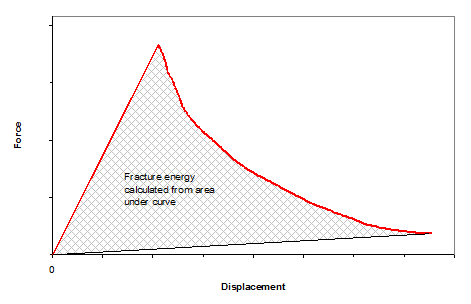The fracture energy for static mode I delamination can be measured using a Double Cantilever Beam, or DCB test [2]. The test sample has a crack placed into it during manufacture. This predefined crack is then extended by applying a load to the faces of the sample both above and below the crack. This can be achieved by gluing hinges onto each surface. These hinges are then clamped into experimental apparatus which pulls them apart. The test machine used to apply the load to the sample also allows the sample to move uniaxially along its length by a set of rollers as illustrated in Figure 5.10: Illustration of the Double Cantilever Beam Test.
The applied force and the displacement of the cantilevers are used to derive the energy consumed for crack propagation. The fracture energy GIC is deduced by normalizing over the delaminated area.
A typical force/displacement curve is displayed in Figure 5.11: Force – Displacement Curve for Determination of the Mode I Fracture Energy Release Rate. Before the onset of crack propagation the slope of the curve is linear. Subsequently a decreasing force level is observed caused by an increasing lever of the test machine.
Figure 5.11: Force – Displacement Curve for Determination of the Mode I Fracture Energy Release Rate

For full experimental details, see [2].



